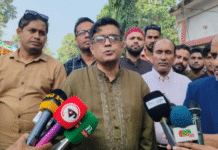Inaction, delay in manpower allocation paved the way for illegal buildings
These illegal structures encroach on a canal besides the Dhaka- Chittagong road at Siddhirganj in Narayanganj district. The photo has been taken recently.
Noted architects and civil engineers blame catastrophic building disasters like Rana Plaza collapse on lack of effective control of Rajuk over building construction and government’s foot-dragging over approving required manpower.
Since 2007, the Rajdhani Unnayan Kartripakkha (Rajuk) has had five designated officials in a building construction committee responsible for approving building construction in Savar.
The committee, comprised of a board member, an assistant director and an executive engineer of Rajuk, assistant chief architect of department of architecture and a government-appointed authorised officer, had a revised jurisdiction over Turag, part of Ashulia and Tongi and Gazipur Sadar in April this year.
But they never appeared to enforce building law there, said Mubasshar Hussein, president of Institute of Architects Bangladesh.
It is apprehended that building law, safety precautions and mandatory Bangladesh National Building Code (BNBC) have not been followed in constructing thousands of buildings in Savar and other fringe areas of the capital, he said.
Authorised Officer Md Helal Ahmed said they inspected approval of only around 50 buildings in Savar over the past several months and could not check all the buildings due to lack of adequate number of inspectors. He said it is not possible to ascertain the number of illegal buildings in Savar without a survey.
Rajuk chairman Md Nurul Huda said they could not control construction of buildings beyond the city’s core area due to lack of manpower. They also could not go for enforcing building law in areas like Savar because of “vehement opposition” by local municipal authorities.
But Mubasshar said Rajuk did lodge a case against Rana Plaza owner for the collapse, which claimed more than 1,100 lives, accusing him of violating Buildting Construction Act and the BNBC. It proves Rajuk is the authority responsible for enforcing laws there.
He rejected Rajuk chairman’s excuse saying there are scores of example of illegal high-rise buildings even in the capital’s core area, where Rajuk has remained mysteriously silent. “So, the excuse is unacceptable.”
Rajuk chairman said they placed a revised organogram to the government seeking increase in manpower from 1,087 to 1,980 but it took two and half years to get approval from housing and public works ministry, finance ministry and the cabinet.
Then it took six months for public administration ministry to approve the recruitment rules and they have to further wait for law ministry’s vetting, he said, the new organogram will add 200 inspectors to existing 40, 20 authorised officers to existing 4 and 7 executive magistrates to existing one.
As to long delay in endorsing required manpower, Abdul Mannan Khan, state minister for housing and public works, said that it was due to financial constraints and long bureaucratic process involving finance ministry, planning ministry and public administration ministry.
Rajuk is legally responsible to control development within its 1,528-square kilometres area of Dhaka Metropolitan Development Plan (master plan) as per Town Improvement Act.
“Rajuk has taken upon itself too heavy a load,” said noted civil engineer Prof Jamilur Reza Chowdhury, “It should disaggregate responsibility.”
Evasive role of Rajuk and defiant role of local government bodies have paved the way for an unspecified number of illegal buildings creeping up in Savar, Tongi, Gazipur, Narayanganj, Keraniganj, Fatullah, Demra and Sabujbagh, official documents show.
Meanwhile, various municipal authorities, including that of Savar, have approved hundreds of buildings within Rajuk jurisdiction despite they lack required by laws and technical manpower further aggravating the risk factor.
As per Building Construction Act and BNBC, only an authorised officer along with a building construction committee can approve a building design within an area of an approved master plan.
Such approval also requires supervision by enlisted architect, structural engineer, geotechnical engineer, a town planner as per laws and above all a set of rules. But a Pourashava lacks all of those.
The municipality ordinance has a sketchy provision for building approval by Pourashavas. Rajuk wrote to Savar Pourashava mayor in January this year asking him not to approve building designs within Rajuk’s jurisdiction.
The nine-story Rana Plaza was built with a municipality approval for five stories and is located within Rajuk master plan.
Source: The Daily Star










